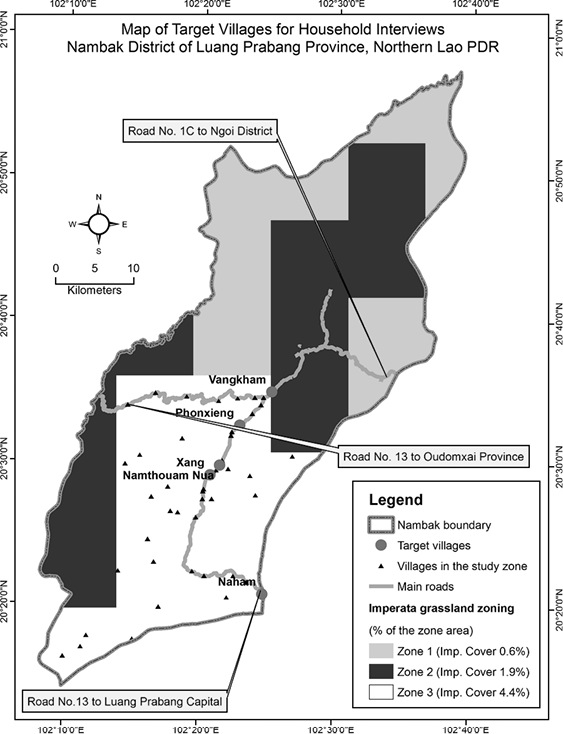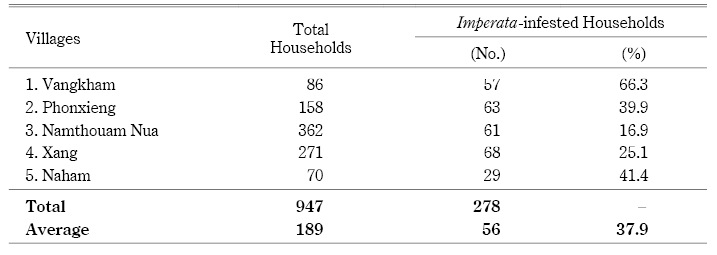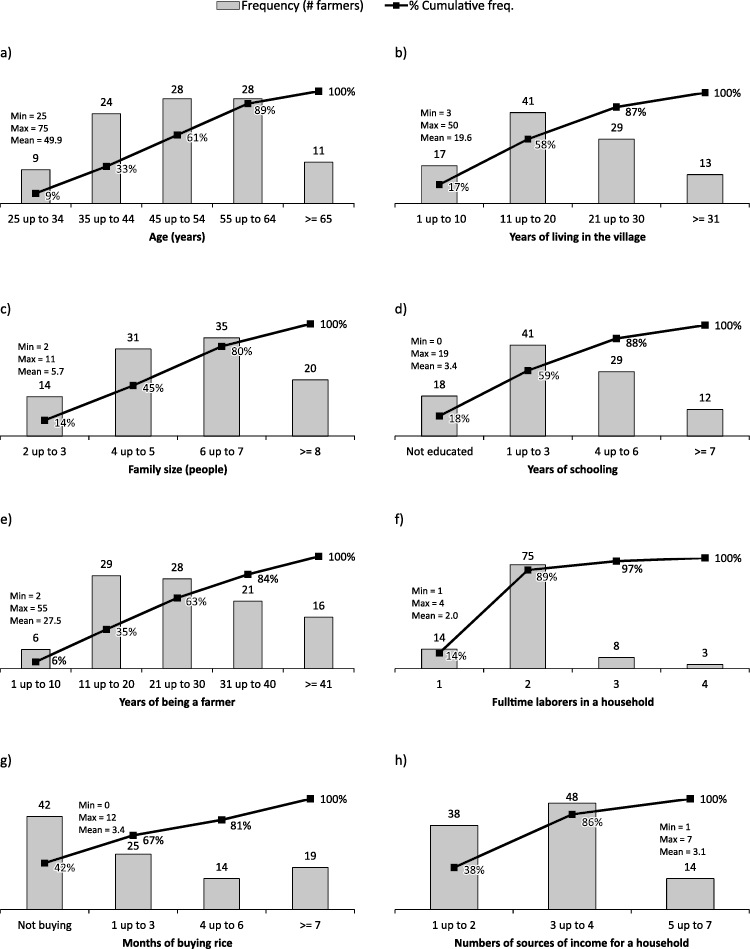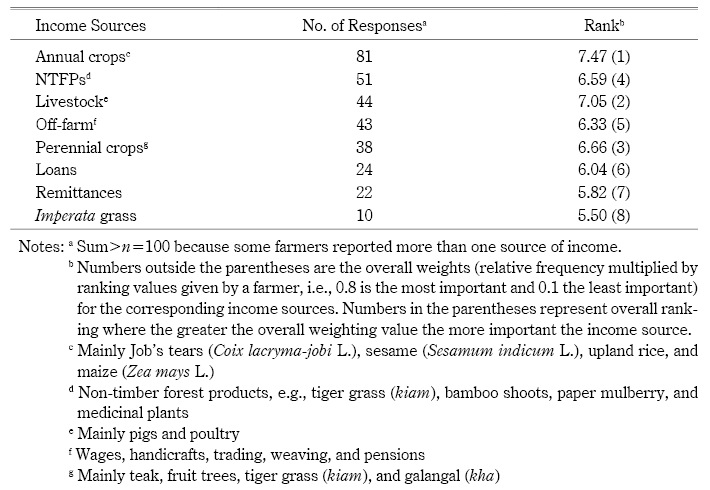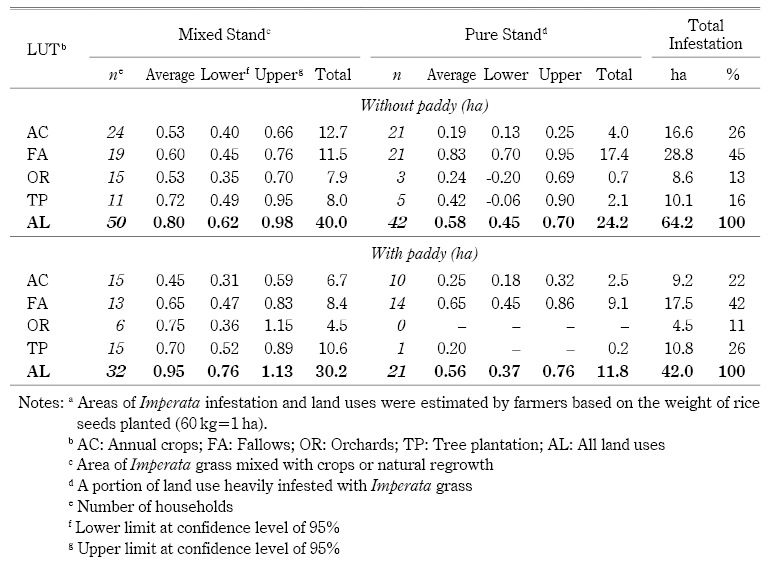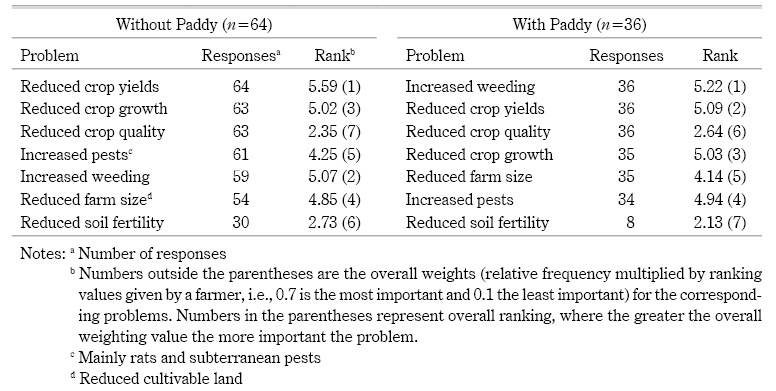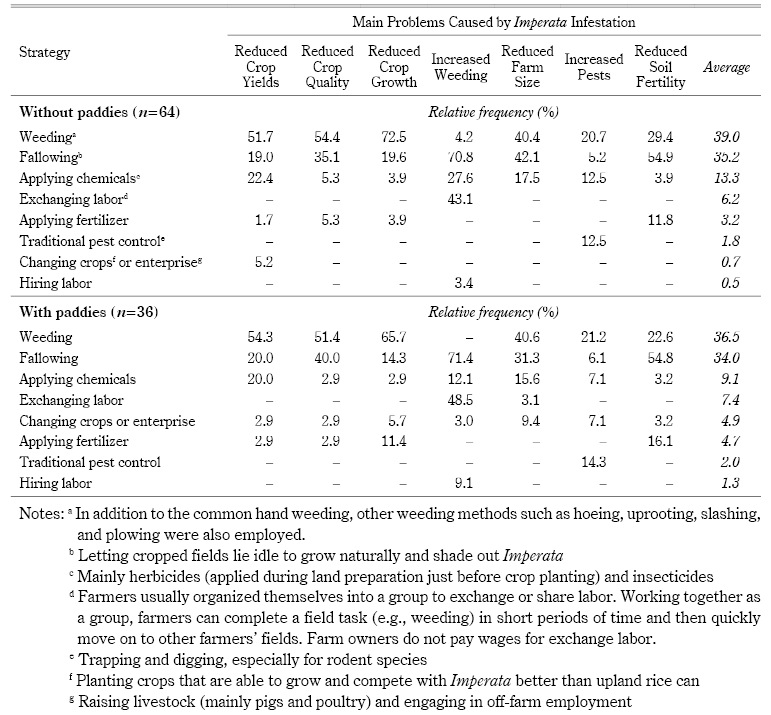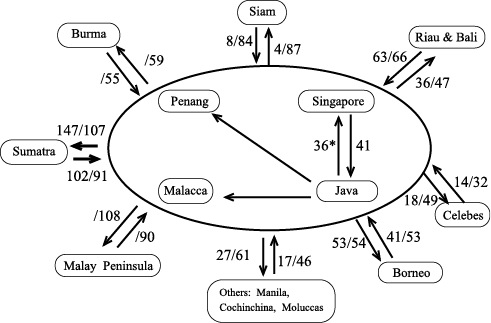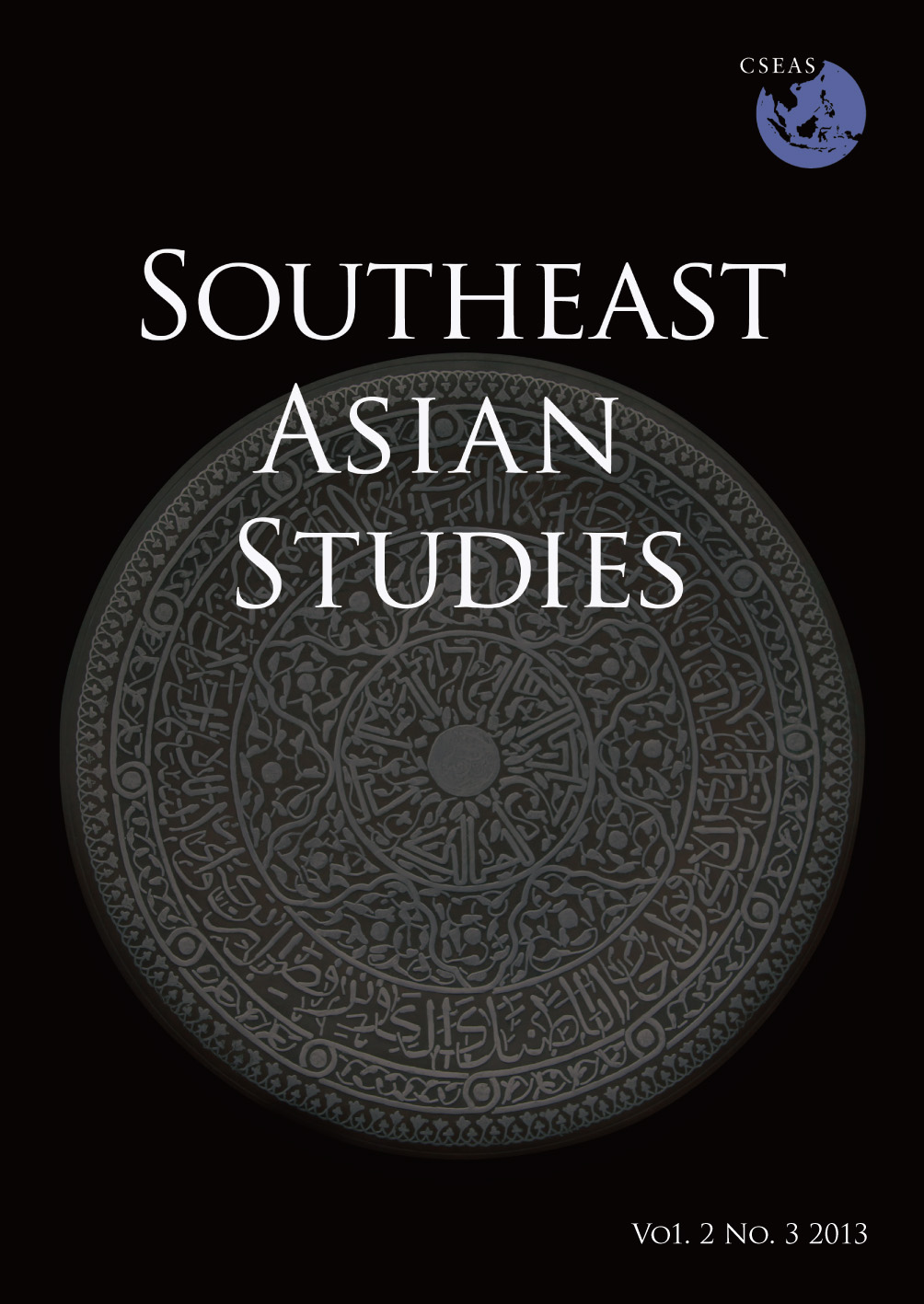RESEARCH REPORT
Farmers’ Perceptions of Imperata cylindrica Infestation in a Slash-and-Burn Cultivation Area of Northern Lao PDR
Bounthanh Keoboualapha,* Suchint Simaraks,* Attachai Jintrawet,** Thaworn Onpraphai,** and Anan Polthanee*
* ບຸນ ທັນ ແກ້ວ ບົວ ລະພາ; สุจินต์ สิมารักษ์; อนันต์ พลธานี, System Approaches in Agriculture Program, Faculty of Agriculture, Khon Kaen University, 123 Moo 16 Mittapap Rd., Nai-Muang, Muang District, Khon Kaen 40002, Thailand
Corresponding author (Bounthanh Keoboualapha)’s e-mail: k.bounthanh[at]gmail.com
** อรรถชัย จินตะเวช; ถาวร อ่อนประไพ, Crop Science and Natural Resources Department and Center for Agriculture Resource System Research, Faculty of Agriculture, Chiang Mai University, 239 Huay Kaew Road, Muang District, Chiang Mai 50200, Thailand
DOI: doi.org/10.20495/seas.2.3_583
This paper discusses farmers’ perceptions of Imperata infestation and its impact on agricultural land uses in a slash-and-burn area of Nambak District in Luang Prabang Province, northern Laos. Our study showed that slash-and-burn cultivation (SBC), which has been practiced for generations, remains the main agricultural land use system and provides an important source of food and income for farmers. Imperata, which first took root one and a half decades ago, is gradually proliferating, affecting the livelihoods of nearly 38% of households in the five target villages of this study. The positive cause-and-effect relationship among such factors as accelerated land clearing, young fallows, declining soil fertility, and land shortages—suggested to be the main cause of the Imperata infestation—has reduced not only cultivable land but also its productivity. According to the majority of farmers, the most significant problems caused by Imperata infestation are reduced crop yields, increased weeding, and reduced crop growth. To overcome the problems, farmers employ a combination of strategies—the most common being weeding, fallowing the land, applying chemicals, and exchanging labor. However, the implementation of these strategies is encumbered by many constraints, primarily lack of labor and capital, rice insufficiency, and limited land. Given the constraints and the available technologies, it will be very difficult for farmers in the study area to adopt a more permanent, diversified, and productive agricultural system, which is a high priority of government development policy in the uplands. To meet this challenge, the thrust of research and development communities working in the uplands should be on more systematic and integrated interventions that combine technological, social, economic, and political resolutions based on knowledge of the causes of Imperata infestation, the problems it creates, management strategies to cope with the infestation, and the specific constraints perceived by farmers.
Keywords: slash-and-burn cultivation, Imperata infestation, agricultural land uses
I Introduction
Slash-and-burn cultivation (SBC), also called shifting cultivation, is an important food production system widely practiced in the tropical mountainous regions of Southeast Asia (Rasul and Gopal 2003). SBC practices, which involve repeated cycles of slashing and burning of secondary forest or shrub vegetation, temporarily growing crops, and then letting the land revert to secondary forest growth or fallows, are similar throughout the region. In Laos, the SBC system is practiced in about 13% of the land by 39% of the total population (JICA 2001) and is viewed by the government as an unsustainable form of land use. It needs to be replaced with more permanent and productive land use systems.
The SBC system in Laos has been less and less productive in recent decades as a result of the reduction of fallow periods and the introduction of new species of weeds. Average fallow periods reported for the 1950s, 1970s, 1990s, and 2000s were 38, 20, 5, and 2–3 years respectively (Roder et al. 1997; Saito et al. 2006). Short fallow periods serve to increase weed infestation in upland rice (Roder et al. 1995), deteriorate soil fertility (Gourou 1942; Whitaker et al. 1972; Brown and Lugo 1990; Fujisaka 1991), and lead to a decline in non-timber forest products (NTFPs) (Foppes and Ketphanh 2005). The increase in population coupled with improper planning and implementation of upland development policies in many SBC areas has resulted in more land shortages and rural poverty (ADB 2001; Jones et al. 2005).
Imperata cylindrica is one of the most dominant, competitive, and difficult weeds to control in the humid and sub-humid tropics of Asia, West Africa, and Latin America. It is one of the most stubborn weeds in both SBC as well as intensive agriculture in West Africa (Chikoye et al. 1999; 2002). Lao upland farmers in the north perceive Imperata to be one of the most important weeds after Ageratum conyzoides, Chromolaena odorata, Commelina spp., Panicum trichoides, and Lygodium flexuosum and one of the most undesirable fallow species after Cratoxylon prunifolium and Symplocos racemosa in slash-and-burn rice systems (Roder et al. 1995; 1997). Imperata is also perceived as a key indicator of poor soil and land degradation (Saito et al. 2006; Lestrelin et al. 2010).
There may be as much as 57 million hectares of Imperata grassland in Asia, about 25 million hectares of which is in Southeast Asia. In Laos, Imperata was reported to have the potential to invade 0.8–1 million hectares (World Bank and Australian International Development Assistance Bureau 1989; Garrity et al. 1997), a figure that is expected to have increased in recent decades. There are primarily two reasons for this: shortened fallow periods, due to which the suppression of aggressive weeds such as Imperata cylindrica is less effective; and/or intensive use of short fallow lands for crop production where Imperata is still dominant.
Our study on the spatial distribution of Imperata grassland (characterized as a “micro-grassland”) in northern Laos revealed that it was unevenly distributed throughout the study area (Fig. 1). In addition, the study found that increased land use intensification through diversifying SBC areas into more permanent crop production systems was strongly correlated with the spread of Imperata grassland (Keoboualapha et al. 2013). The purpose of this study was to capture the local perceptions of such infestation and its impacts on agriculture. The more specific objectives of the study were: (1) to characterize the main agricultural land uses and major crops in the most Imperata-infested area of Nambak District in Luang Prabang Province, northern Laos; (2) to estimate the extent of and describe Imperata infestation at the household level as perceived by affected farmers; and (3) to identify the existing strategies and constraints in dealing with Imperata infestation. The findings of this study will highlight the significance of Imperata grassland to concerned research and development communities as a crucial issue for sustainable development in the uplands of Laos.
II Materials and Methods
II-1 Study Area
The study area is located in the southeast part of Nambak District, about 100 kilometers northwest of the capital of Luang Prabang Province, occupying a total area of 72,200 hectares or 37% of the district’s territory. This area (Zone 3 in Fig. 1) has been identified as the most Imperata-infested zone, with an average Imperata infestation level of 4.4%. It is characterized as an area of very intensive land use, a significant amount of shrub forest, and less natural and bush forests as compared to the other zones, i.e., Zones 1 and 2. Five villages in this zone were chosen for the household interviews (Fig. 1). The selection of the villages was based on the recommendation of the district Agriculture and Forestry Office.
II-2 Household Sampling Method
At the outset, an informal meeting was held with the village headmen and their committees to inform the villagers of the objectives of the study. At the meeting, the appropriate authority of each village was asked to differentiate its farmers into sets of those who had and did not have Imperata infestation on their farmland. All the lists with the names of farmers from the five villages whose fields were infested by Imperata were compiled into a single list comprising 278 households (Table 1); this list was, in turn, used for selecting households/farmers for individual interviews. A total of 100 from the 278 households pooled were randomly selected with the help of a table of random numbers.
II-3 Data Collection
A structured questionnaire was developed for the individual farmer interviews. All the information that related to socioeconomic data, land uses, and Imperata infestation was collected for the wet season of 2011. Questionnaire pretesting exercises were conducted outside the five target villages to further fine-tune the data collection process. The actual interviews of 100 farmers were conducted after the pretesting.
II-4 Data Analysis
Microsoft Excel software was used as a tool for the data processing and statistical analyses. Descriptive statistics, including mean, frequency, and confidence level, were used to describe the important characteristics of the farmers with Imperata infestation within the study area. In addition, a semi-quantitative matrix ranking method (Ashby 1990) was used to rank the importance of Imperata infestation-related issues as reported by the farmers.
III Results and Discussion
III-1 Socioeconomic Characteristics of Farmers with Imperata-Infested Land
The sample statistics indicate that 89% of the farmers interviewed were less than 65 years old, with 80% between the ages of 35 and 64 (Fig. 2a). About 87% of the farmers had been living in their villages for less than 31 years and 13% for more than 30 years to a maximum of 50 years (Fig. 2b). The average family size was 5.7 persons. About 66% of families had between four and seven members (Fig. 2c). They mostly had low educational levels, with an average of 3.4 years in school. About 88% of the farmers had attended school for six years or less—among them, 18% had not been to school at all (Fig. 2d).
Most of the farmers interviewed (94%) had been farming for more than 10 years (Fig. 2e). They commonly had limited manual labor to help with farming activities: only about 89% of them had one or two full-time laborers (Fig. 2f).
About 58% of the farmers reported that they experienced a shortage of rice in 2011. It was common enough to purchase rice for three to four months a year. That year, however, the shortage was so severe that about 19% of the farmers had to buy rice for more than six months (Fig. 2g). It was observed that the farmers rarely relied on a single source of income to support their families but combined various sources. About 62% of the farmers interviewed had income from more than two sources (Fig. 2h).
Annual crops were by far the most important source of income for most farmers in the study area, followed by livestock, perennial crops, NTFPs, and off-farm activities. NTFPs, although ranked fourth in the income scale, ranked second for a large number of farmers after upland annual crops. About 10% of the farmers said that Imperata grass also provided a source of income, but it was much lower down the scale when compared to other income sources (Table 2).
III-2 Main Agricultural Land Uses and Major Crops
Upland annual crop production, fallows, orchards, tree plantations, and paddy were identified as the main agricultural land uses adopted by farmers. SBC, which involves growing upland annual crops and fallowing the lands, was important not only for farmers who had no paddy but also for farmers who had paddy fields. In 2011, 27 of the 36 farmers who had paddy fields had upland annual crops occupying about 25% of their farmland (Table 3).
The sample statistics indicate that the average farm sizes were not significantly different, ranging from 2.87 to 2.97 hectares hh–1. The average size of farms rated with a confidence level of 95% ranged between 2.48 and 3.26 hectares hh–1 and 2.53 and 3.42 hectares hh–1 for farmers with and without paddy fields, respectively. Upland annual crops and fallows were the most important land uses practiced by both groups of farmers, and comprised 75% and 47% of the farm area owned by farmers without and with paddy fields, respectively. Land use intensification through perennial crop diversification had reduced the slash-and-burn area by 25% and 30% for farmers without and with paddy fields, respectively. In addition to upland annual crops, farmers with paddy tended to intensify their slash-and-burn areas into tree plantations, while farmers without paddy intensified into both tree plantations and orchards (Table 3).
III-3 Farmers’ Perceptions of Imperata Infestation in Relation to Land Uses: Persistence and Areas
The longest period of Imperata invasion into farmlands, as recalled by the farmers interviewed, was 21 years. However, about 95% of farmers reported that Imperata had invaded their fields for less than 16 years (Fig. 3a). As a result, we believe that Imperata has only recently rooted itself in the study area. Almost all farmers mentioned that the Imperata-infested areas had expanded and compacted together in some parts of their farmland.
Asked about their perceptions on the mode of proliferation and persistence of Imperata in the area, 91% of the farmers interviewed reported that accelerated clearing of the same piece of land by either slashing or burning practices, short fallow periods (one to two years) or young fallows, and poor soil were the factors essentially responsible for Imperata grass infestation (Fig. 3b). The limited areas of land available for SBC compelled the farmers to reduce the length of the fallow periods, which in turn contributed to low soil productivity. Poor soil and dry lands were often repeated problems among the farmer interviewees. On the other hand, because of the reduction in the SBC area, short fallow land had to be cleared more frequently for annual cropping, which again reduced soil productivity and increased the annual weed population.
Due to low biomass, short fallows can result in weak burning. A good burn improves soil productivity through the addition of fertilizer derived from ash and reduced weeds (Saito et al. 2006). This study therefore suggests that the positive cause-and-effect relationship between the aforementioned factors is an important cause of Imperata infestation in the study area.
Farmers mentioned that Imperata grass had invaded fields under different types of land uses. They identified two types of Imperata grass infestation: mixed and pure. The former refers to land use or fields where Imperata grass grows together with crops or natural vegetation and is known as “mixed Imperata stand,” while the latter refers to land use or fields where Imperata grass grows with a few, or without any, other plant species and is known as “pure Imperata stand.” Imperata infestation area (patch or field size), given a confidence level of 95%, was 0.62–1.13 hectares and 0.37–0.76 hectares for mixed and pure infestation, respectively (Table 4).
The farmers claimed to have experienced higher mixed, rather than pure, infestation. The most infested land uses were fallows and tree plantation, consisting of 53.7% and 77.7%, and 40.9% to 44.8% of the total area of the particular land uses, or 15% and 5%, and 17% and 10% of the total farm area owned by farmers without and with paddy (Table 5). In addition, farmers with paddy were found to have more severe Imperata infestation than farmers without paddy (41% versus 34%). Therefore, it is important that farmers who own paddy fields should not be ignored by the agencies concerned when developing sustainable Imperata management strategies in the uplands.
In general, about 37% of the total farmland covered by our study is infested by Imperata: about 12% is unproductive for cropping because it is invaded by the pure variety of Imperata infestation explained above, and 25% has been rendered less productive with a high risk of crop failure due to mixed Imperata infestation. The remaining 63% of farmland, untouched thus far by Imperata, is expected to be more productive and therefore suitable for upland crop production. However, this area can also be at risk from an Imperata invasion unless proper control and management practices are implemented.
III-4 Farmers’ Perceptions of Imperata Infestation in Relation to Crop Production: Problems, Management Strategies, and Constraints
When farmers were asked to rank the problems they considered offshoots of Imperata infestation in ascending order of importance, most of them cited more than one challenge. They believed that reduced crop yields, increased weeding procedures, and reduction in crop growth were the most significant impacts of Imperata infestation (Table 6). Repeated clearing of short fallow land for annual cropping, while Imperata is still dominant, significantly increases the need for weeding. As a result, maintaining crop yields by providing adequate weeding can be a great challenge for farmers in the study area. Chikoye et al. (2000) estimated crop yield reduction attributable to competition from Imperata grass to be 76–80% in cassava, 78% in yam, and 50% in maize. International Institute of Tropical Agriculture (IITA) (1997) reported that weed control operations in Imperata-infested fields could be required as often as three to six times per season depending on the type of crop and the level of infestation. Reduced farm size or cultivable land was considered a less significant problem, although farm sizes had reportedly been reduced by 12.7% due to pure Imperata infestation. Reduced soil fertility was also considered less important in the study area, although some studies in other areas of northern Laos reported that farmers cited the presence of Imperata as a key indicator of poor soil and land degradation (Saito et al. 2006; Lestrelin et al. 2010).
To cope with the problem of Imperata infestation, farmers use a wide range of management strategies. Some measures, such as weeding, fallowing the land, applying chemicals and fertilizers, and pest control, are technological/technical; while exchange labor, changes to new crops or enterprises, and the hiring of laborers are more economic and/or social. Weeding, fallowing the land, applying chemicals, and exchange labor are the chief strategies adopted by farmers both with and without paddy fields to tackle most of the issues that they face (Table 7). The planting of new crops and the setting up of new enterprises such as raising livestock or off-farm activities are important strategies adopted by farmers when the regular crop produces very low yield. Many farmers in the study area have switched from the cultivation of upland rice to the cultivation of Job’s tears or maize because the latter crops can compete with Imperata and grow better on their farms.
However, there are many constraints to the effective implementation of such strategies. Most of the constraints cited by the interviewees are social and economic rather than technological/technical. Lack of labor and capital, a shortage of rice, and limited cultivable land are considered the chief constraints by farmers (Table 8). The lack of technology and knowledge in dealing with the problems caused by Imperata is considered a less important constraint; this indicates that the farmers are satisfied with their current level of knowledge and prevailing technologies. This is probably because the farmers have no idea, nor information, of the improved technologies available for dealing with Imperata infestation. With the limited technological options within their command, they continue to pursue their traditional SBC practice although the government strives to discourage it.
IV Conclusion
The study found that Imperata infestation, which was established about one and a half decades ago, is gradually spreading in the study area and affecting the livelihoods of nearly 38% of households living in the five target villages. Slash-and-burn cultivation (SBC) remains the main agricultural land use system and provides an important source of food and cash income for farmers. Most of the farmers are concerned about the negative impacts of Imperata, although it does yield income in small measure to some farmers. The positive cause-and-effect relationship between the accelerated clearing of the same piece of land, short fallow periods, declining soil productivity, and land shortage is believed to be the primary cause of Imperata infestation in the study area.
The study has shown that about 37% of farmland is infested with Imperata: 12% is rendered unproductive for cropping due to the pure form of the infestation, while 25% of the land has become less productive, with a high risk of crop failure, due to the mixed form of the infestation. The remaining 63% of farmland, so far free of infestation, is also considered to be at risk unless appropriate preventive management practices are employed.
It is the considered view of most of the farmers interviewed that reduced crop yield, increased weeding, and reduced crop growth are the chief problems caused by Imperata infestation. To cope with these issues more effectively, the farmers often implement a combination of strategies and practices, the most common of which are weeding, fallowing the land, applying chemicals, and exchange labor. However, such measures encounter many constraints due to lack of labor and capital, land shortages, rice shortage, and limited land. Given the constraints faced and the prevailing technologies used, increased Imperata infestation in fallow lands will make it very difficult for farmers to intensify the SBC system into a more permanent, diversified, and productive agricultural system, which is a high priority of the government development policy in the uplands. To meet this challenge, knowledge about the causes, problems, and management strategies and acknowledgement of the constraints perceived by farmers vis-à-vis Imperata infestation must be collated, correlated, and addressed by the research and development communities working in the uplands. This will enable systematic and integrated interventions combining technological, social, economic, and political resolutions.
Accepted: February 7, 2013
Acknowledgments
We thank the Agriculture and Forestry Office of Nambak District for providing staff to work with us and the communities; local community leaders for their help organizing villagers; and the farmers for valuable information. This study was financially supported by the Thailand Research Fund under the CLMV-T DSS Graduate Degree Program Research Initiative: 1st Phase (Contract No. RDG52O0003-LV01).
References
ADB. 2001. Participatory Poverty Assessment. Vientiane: Asian Development Bank.
Ashby, J. A. 1990. Evaluating Technology with Farmers: A Handbook. Cali, Columbia: International Center for Tropical Agriculture.
Brown, S.; and Lugo, A. E. 1990. Effects of Forest Clearing and Succession on the Carbon and Nitrogen Content of Soils in Puerto Rico and US Virgin Islands. Plant and Soil 124: 53–64.
Chikoye, D.; Ekeleme, F.; and Ambe, J. T. 1999. Survey of Distribution and Farmer Perceptions of Speargrass (Imperata cylindrica) in Cassava-Based Cropping Systems in West Africa. International Journal of Pest Management 45: 305–312.
Chikoye, D.; Manyong, V. M.; and Ekeleme, F. 2000. Characteristics of Speargrass (Imperata cylindrica) Dominated Fields in West Africa: Crop, Soil Properties, Farmer Perceptions and Management Strategies. Crop Protection 19: 481–487.
Chikoye, D.; Manyong, V. M.; Carsky, R. J.; Ekeleme, F.; Gbehounou, G.; and Ahanchede, A. 2002. Response of Speargrass (Imperata cylindrica) to Cover Crops Integrated with Handweeding and Chemical Control in Maize and Cassava. Crop Protection 21: 145–156.
Foppes, J.; and Ketphanh, S. 2005. Non-timber Forest Products for Poverty Reduction and Shifting Cultivation Stabilization in the Uplands of Lao PDR. In Poverty Reduction and Shifting Cultivation Stabilization in the Uplands of Lao PDR: Technologies, Approaches and Methods for Improving Upland Livelihoods, edited by Bounthong Bouahom, Aiden Glendinning, Sophie Nilsson, and Michael Victor, pp. 181–193. Vientiane: NAFRI.
Fujisaka, S. 1991. A Diagnosis Survey of Shifting Cultivation in Northern Laos: Targeting Research to Improve Sustainability and Productivity. Agroforestry Systems 13: 95–109.
Garrity, D. P.; Soekardi, M.; Van Noordwijk, M.; De la Cruz R.; Pathak, P. S.; Gunasena, H. P. M.; Van So, N.; Huijun, G.; and Majid, N. M. 1997. The Imperata Grasslands of Tropical Asia: Area, Distribution and Typology. Agroforestry Systems 36: 3–29.
Gourou, P. 1942. L’utilisation du sol en Indochina [Utilization of soils in Indochina]. Center d’études de politique étrangère. Paris: Paul Hartmann.
IITA. 1997. Annual Report 1987. Ibadan: International Institute of Tropical Agriculture.
JICA. 2001. Master Plan Study on Integrated Agriculture Development in Lao PDR, 3 vols. Lao PDR: Japan International Cooperation Agency and Ministry of Agriculture and Forestry.
Jones, P.; Sysomvang, S.; and Amphaychith, H. 2005. Village Land Use and Livelihood Issues Associated with Shifting Cultivation, Village Relocation and Village Merging Programmes in the Uplands of Phonxay District, Luang Prabang Province. In Poverty Reduction and Shifting Cultivation Stabilization in the Uplands of Lao PDR: Technologies, Approaches and Methods for Improving Upland Livelihoods, edited by Bounthong Bouahom, Aiden Glendinning, Sophie Nilsson, and Michael Victor, pp. 149–159. Vientiane: NAFRI.
Keoboualapha, B; Onpraphai, T; Jintrawet, A; Simaraks, S; and Polthanee, A. 2013. Imperata Grassland Mapping in Northern Uplands of Lao PDR: Areas, Distribution, Characteristics and Implications for Slash-and-Burn Cultivation. Southeast Asian Studies 2(2): 383–399.
Lestrelin, G.; Pelletreau, A.; and Valentin, C. 2010. Local Knowledge and Land Degradation: A Participatory Case Study in the Uplands of Laos. Vientiane: IRD-IWMI-MSEC Project.
Rasul, G.; and Gopal, G. B. 2003. Shifting Cultivation in the Mountains of South and Southeast Asia: Regional Patterns and Factors Influencing the Change. Land Degradation and Development 14: 495–508.
Roder, W.; Phengchanh, S.; and Keoboualapha, B. 1997. Weeds in Slash-and-Burn Rice Fields in Northern Laos. Weed Research 37: 111–119.
Roder, W.; Phengchanh, S.; Keoboualapha, B.; and Maniphone, S. 1995. Chromolaena odorata in Slash-and-Burn Rice Systems of Northern Laos. Agroforestry Systems 31: 79–92.
Saito, K.; Linquist, B.; Keoboualapha, B.; Shiraiwa, T.; and Horie, T. 2006. Farmers’ Knowledge of Soils in Relation to Cropping Practices: A Case Study of Farmers in Upland Rice Based Slash-and-Burn Systems of Northern Laos. Geoderma 136: 64–74.
Whitaker, D. P.; Barth, H. A.; Berman, S. M.; Heimann, J. M.; MacDonald, J. E.; Martindale, K. W.; and Shinn, R. S. 1972. Area Handbook for Laos. Washington, DC: US Government Printing Office.
World Bank and Australian International Development Assistance Bureau. 1989. Lao PDR: Preparation Report, Fifth Agricultural Development Project.

